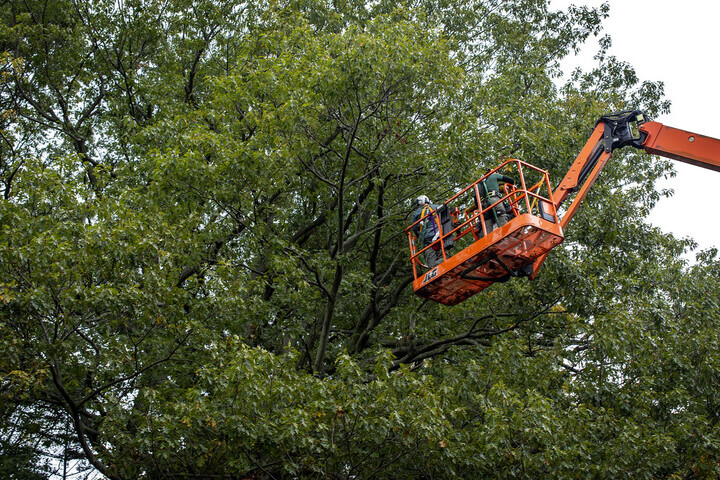Brooklyn Botanic Garden is working to preserve the beloved hybrid oak tree on Daffodil Hill. The tree was damaged in August and needs extra support so that a three-foot crack in its trunk doesn’t split and give way.
The 86-foot-tall tree has a 119-foot spread and has one of the most distinctive forms in the Garden with horizontal limbs that stretch out over the walking path at the base of the hill.

The hybrid, sometimes called the Hawkins Oak, is a naturally occurring hybrid (Quercus × hawkinsiae) that was first discovered by chance in 1912 by a Mrs. Eugene Hawkins, who noticed something odd about the acorns beneath one of the trees on her 25,000-acre estate in western Tennessee. Though the acorns came from what she’d believed to be a red oak, they had yellow flesh rather than the typical white.
Looking more closely, she also noticed that the tree itself had characteristics of both the red oak (Q. rubra) and black oak (Q. velutina) species—its trunk bark was like a red oak’s, but some of its leaves were the shape and size of a black oak’s, for starters. After further study, it was eventually determined that the tree and its offspring were indeed a cross between the two species, both of which were growing in the vicinity.
Oaks produce tiny, wind-pollinated flowers, and it’s pretty common for them hybridize in the wild, says Chris Roddick, foreman of grounds. Many probably live and die out without anyone really noticing, but a small number have been selected and cultivated in nurseries.
In the case of Quercus × hawkinsiae, Mrs. Hawkins shared the acorns with a friend, who managed to grow at least one seedling. A botanist named George Sudworth also planted some at the arboretum at Letchworth State Park in New York, where at least one more seedling emerged. It was Sudworth who first wrote about Quercus × hawkinsiae, in a forestry journal in 1917.
The origins of the Garden’s own specimen are a bit of a mystery. Its accession number—the unique number assigned to each plant for documentation—is missing its year, and its source is unknown as well. But since the hybrid name was recorded, we know that it must have been planted some time after 1927 when it was officially named.
After BBG’s specimen was damaged, the Garden spent some time investigating and considering options. An outside expert at Cahilly’s Horticultural Services in New Jersey examined the tree and recommended a plan for preserving it.
Rowan Blaik, Brooklyn Botanic Garden’s director of Living Collections also searched plant databases for specimens at other botanic gardens and institutions and found only a handful, the oldest of which were accessioned in the 1970s.
That means the Garden’s tree could be the oldest in cultivation, says Blaik. Since the hybrid is so new, its lifespan isn’t known. And since there are so few others to compare it with, it’s hard to estimate its age. The tree is still growing vigorously, though, a sign that it could still have a long life ahead once it’s supported. Some oak species can live for hundreds of years.

The crack occurred at the trunk at the junction where the tree’s two main limbs (called leaders) branch off, says BBG’s director of Horticulture, Ronnit Bendavid-Val. To preserve the tree, the Garden’s horticulture team will insert steel rods through the cracked trunk to pull it together and then secure the leaders with cables, a tried and true method that oaks tend to respond really well to, says Roddick. The team is also pruning the tree’s canopy to lighten the load on the trunk and leaders.
The work should be done in a week or so, and then the surrounding area and walking path will reopen. “It’s such a lovely specimen with this open, branching form, and there’s so much space around it, so you can really stand back and appreciate this tree,” says Blaik. “It seemed pretty happy until the split, so we hope for a long, healthy life for it.”